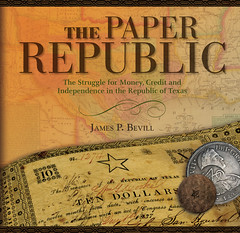
PREV ARTICLE
NEXT ARTICLE
FULL ISSUE
PREV FULL ISSUE
BOOK REVIEW: THE PAPER REPUBLIC (OF TEXAS) BY JAMES BEVILL
Well, this box was hefty, so I said it was a review copy. When I opened the box I just said "Wow!" It was James Bevill's new book, The Paper Republic, The Struggle for Money, Credit and Independence in the Republic of Texas. Larger than I'd imagined, the massive 354-page hardcover book is coffee-table sized at nearly 11" x 11". It has a color pictorial cover PLUS a glossy color dust jacket. First, it's much more than just a coin or paper money book. It is very much a history book, but one illustrated throughout with images of numismatic items - primarily paper, but also coins. I made a beeline to the section on the New Spain Jolas of 1817-1818, and I wasn't disappointed. Eight different specimens were illustrated in color, obverse and reverse, in a four-page section in chapter two. The book has a four-page Bibliography and a seven-page Index - remember, these are BIG Texas-sized pages. But that's not all - each chapter has a page of fine-print endnotes, typically forty in number, nearly eighty in some chapters. Is it a catalogue of Texas numismatic issues? No - you won't find a checklist of all known types and varieties of paper financial instruments, but there are other books that serve those needs. What Bevill's book does is clearly lay out the historical and financial background of all the major issues, with all the good intentions (and bad) of the people responsible for their issue. On p220 for example, is a section titled "A Revolving Door of Deception", about secretly issued 1840 promissory notes. From p322: From the standpoint of numismatists, it is interesting to note that the money of the Republic of Texas is among the scarcest of collectible paper money. The exchequer bills are extremely rare because they were destroyed by the government upon their redemption to prevent their reissue. From p324: Fortunately for collectors and historians of today, there were several thousand pieces of the obsolete money stored in various county depositories.... Many state and county officials, including judges and at least one state treasurer, helped themselves to the old bills from the archives and storage rooms of their respective facilities and discretely sold them for collectors. There are many great anecdotes and interesting stories throughout this beautifully arranged book. I highly recommend it to U.S. numismatists and anyone interested in the history of the state of Texas, numismatist or not. It's a great read. This isn't a book to be sat on the shelf just for reference - it's one that should be savored page by page. Congratulations to Mr. Bevill for his accomplishment; every state deserves to have such a book written, but few have been as blessed as Texas.
To read the earlier E-Sylum, see:
NEW BOOK: THE PAPER REPUBLIC (OF TEXAS) BY JAMES BEVILL
(www.coinbooks.org/esylum_v13n02a03.html)
The Numismatic Bibliomania Society is a non-profit organization promoting numismatic literature. See our web site at coinbooks.org. To submit items for publication in The E-Sylum, write to the Editor at this address: whomren@gmail.com To subscribe go to: https://my.binhost.com/lists/listinfo/esylum All Rights Reserved. NBS Home Page Contact the NBS webmaster 
|
